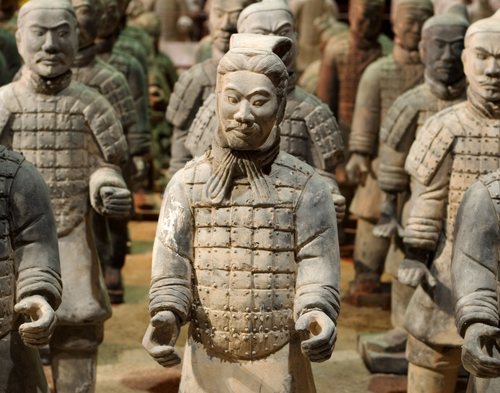
 There more people you kill, the more paranoid you get. You reap in the next life what you sew in this life. I wonder if that was one the reasons Qin Shi Huang, China’s first emperor, needed an entire army to guard him in his afterlife for fear his enemies chopped his dead body into pieces and he couldn’t ‘live’ normally being dead. Complicated I know, but you get the idea.
There more people you kill, the more paranoid you get. You reap in the next life what you sew in this life. I wonder if that was one the reasons Qin Shi Huang, China’s first emperor, needed an entire army to guard him in his afterlife for fear his enemies chopped his dead body into pieces and he couldn’t ‘live’ normally being dead. Complicated I know, but you get the idea.
All guidebooks list the Terracotta Army among the top ten sights to see in China. Even the picture-scarce Lonely Planet uses one page to show the grim faces of these famous giant toy soldiers.
The Terracotta army is band of baked clay brothers, 2000 year-old, life-sized infantry, archers, calvary, colonels, lieutenants, privates (or whatever they called it in that time). However, this troop is only a small part of the grand underground kingdom replicating the emperor’s real kingdom. The man thought he could continue to rule after his death. Guinness Book of World Records recognized the combination of the tomb and the warrior pits as world’s largest tomb, more than the famous Egypt’s pyramid. According to historical records, there were hundreds of rooms, pavilions and palace filled with precious stones, gold and valuable treasures. The palace mirrored heaven and earth where pearls and gems represented sun, moon and stars. One the ground flowed the mercury-filled miniature of Yangtze and Yellow rivers.
Such extravagance took 37 years to finish and required more than 700000 labors who were craftsmen, prisoners, slaves and debt-owing peasants. Crafts-men spent years designed and created jewelry, clothing, ceramics and chariots. Other labors carried stones hundreds of kilometer away. Many died during labor together with the workers on the place who were buried alive to make sure no-one knew how to enter the tomb.
Terrified huh? If you could return to a period in ancient China’s history, stay away from this time.
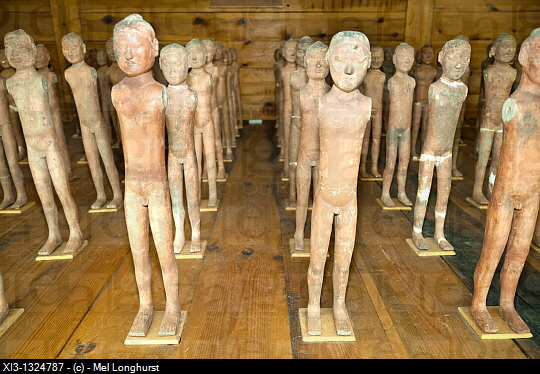 But you could fast-forward the time machine to 50 years later and live a proper, happy life under the Han Emperor Jingdi, the family which ruled China after the collapse of the Qin dynasty. His tomb, known as Han Yangling or Emperor Jingdi’s tomb, is located further away from Xian thus not popular with foreign tourists. It’s worth checking out if you stay longer in Xian. You see more objects up-close than at the Terracotta Army. These warriors are put in a pit so far away and can only be seen in detailed with a camera zoom. In Han Yangling, you walk inside the underground exhibition hall on top of glass surface, thus seeing the relics underneath and around. In addition to terracotta soldiers, there are palace maids, domestic animal figurines, and objects depicting life of the royal families and ordinary people during the Western Han Dynasty (206 B.C. – 23 A.D.). Unlike Qin Shi Huang’s massive soldiers, Jingdi’s troop looks more like a toy collection of a child. His terracotta are small, like a baby next to a full-grown adult.
But you could fast-forward the time machine to 50 years later and live a proper, happy life under the Han Emperor Jingdi, the family which ruled China after the collapse of the Qin dynasty. His tomb, known as Han Yangling or Emperor Jingdi’s tomb, is located further away from Xian thus not popular with foreign tourists. It’s worth checking out if you stay longer in Xian. You see more objects up-close than at the Terracotta Army. These warriors are put in a pit so far away and can only be seen in detailed with a camera zoom. In Han Yangling, you walk inside the underground exhibition hall on top of glass surface, thus seeing the relics underneath and around. In addition to terracotta soldiers, there are palace maids, domestic animal figurines, and objects depicting life of the royal families and ordinary people during the Western Han Dynasty (206 B.C. – 23 A.D.). Unlike Qin Shi Huang’s massive soldiers, Jingdi’s troop looks more like a toy collection of a child. His terracotta are small, like a baby next to a full-grown adult.
Despite the difference, both the Terracotta Army and Han Yangling give you understanding of the burial custom of ancient China.
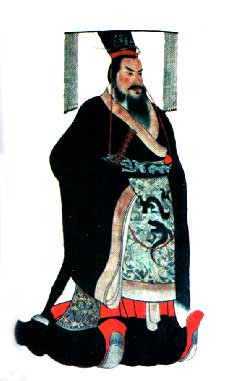
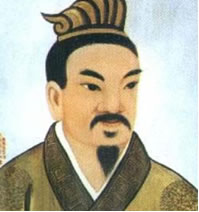 These men could not be more different. Qin Shi Huang, whose name often associated with the Great Wall of China, ascended to the throne at the tender age of 13. Young but tender he wasn’t. He is known as one of the most ruthless kings in Chinese history. His philosophy was along the line of “Crime and Punishment”. He was the kind of rulers you wouldn’t dare freely discuss your opinions, instead you might pee in your pants standing in his court. I read about him first in the book “Most Brutal Dictators in the World”, which described torture methods kings/emperors/rulers used on their prisoners. Unlike many Chinese emperors before and after, Qin Shi Huang hated Confucius teaching which promoted an ordered and ethical society, proper behaviors of righteous men, proper relationship among different individuals and social groups: how king should be king and how men should be men. Yeah good luck to tell someone like Qin Shi Huang how to behave. He ordered to burn all Confucian textbooks and executed anyone who kept them and preached the teaching. Instead he adhered to the teaching of Han Fei, who advocated Legalism doctrine, promoting strict laws and punishment over the ruled subjects. Han Fei believed that people were naturally evil, thus needed to be taught and disciplined. That explained how Qin Shi Huang ruled China with an iron fist.
These men could not be more different. Qin Shi Huang, whose name often associated with the Great Wall of China, ascended to the throne at the tender age of 13. Young but tender he wasn’t. He is known as one of the most ruthless kings in Chinese history. His philosophy was along the line of “Crime and Punishment”. He was the kind of rulers you wouldn’t dare freely discuss your opinions, instead you might pee in your pants standing in his court. I read about him first in the book “Most Brutal Dictators in the World”, which described torture methods kings/emperors/rulers used on their prisoners. Unlike many Chinese emperors before and after, Qin Shi Huang hated Confucius teaching which promoted an ordered and ethical society, proper behaviors of righteous men, proper relationship among different individuals and social groups: how king should be king and how men should be men. Yeah good luck to tell someone like Qin Shi Huang how to behave. He ordered to burn all Confucian textbooks and executed anyone who kept them and preached the teaching. Instead he adhered to the teaching of Han Fei, who advocated Legalism doctrine, promoting strict laws and punishment over the ruled subjects. Han Fei believed that people were naturally evil, thus needed to be taught and disciplined. That explained how Qin Shi Huang ruled China with an iron fist.
It makes perfect sense when most man-made world wonders of superlative scale: biggest, longest, tallest were often built under dictators who had little concern to the people who were forced to pay for the expenses. Xian at the time had only 1 millions and 70% were recruited to work on the Terracotta Army and the mausoleum in addition to the labors working on the Great Wall of China.
On the contrary, Emperor Jingdi loved peace and his people. Together with his father, Wendi, he reigned over a golden era of the Han dynasty. He followed Laozi’s teaching, living in harmony with nature and not intervening with people’s lives. He reduced taxes, reserved food to distribute in the event people lost their crops and avoided costly war by maintaining peaceful relationship with the Hun tribes in the North. You can tell by comparing the child-like terracotta warriors and figurines buried in his tomb to the the world wonder Terracotta Army of Qin Shi Huang. Their designs had fewer details and looked simpler despite being produced years later with more advanced technology (188 BC – 141 BC and 259 BC – 210 BC). Most figures and objects were made from cheap clay and lacquer. Many warriors even lost their arms which were made of wood thus decayed over time.
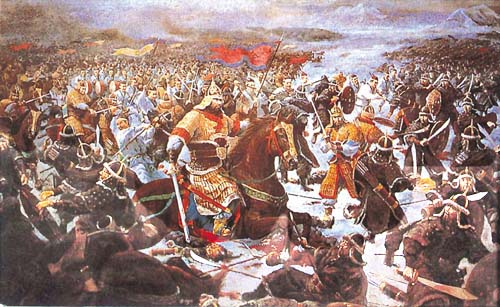 The contrast in styles can be explained by the time and the social environment that these two kings lived in. Ancient China through out its thousands years had always been precarious with constant wars waged within and without. Not only they had to fight with foreign hostile nomadic tribes, they fought among themselves. Remember China’s unification didn’t happen until Qin Shi Huang, and even so, China were often split into various big and small states which waged wars with one another for the emperor title of China. Qin Shi Huang was born into one of the most chaos time of China history, the Warring States period, a Chinese version of Hunger Game when seven main states of China engaged in brutal wars, assignation schemes, exploitation to destroy and annex other states. It was the time of anarchy, greed and power.
The contrast in styles can be explained by the time and the social environment that these two kings lived in. Ancient China through out its thousands years had always been precarious with constant wars waged within and without. Not only they had to fight with foreign hostile nomadic tribes, they fought among themselves. Remember China’s unification didn’t happen until Qin Shi Huang, and even so, China were often split into various big and small states which waged wars with one another for the emperor title of China. Qin Shi Huang was born into one of the most chaos time of China history, the Warring States period, a Chinese version of Hunger Game when seven main states of China engaged in brutal wars, assignation schemes, exploitation to destroy and annex other states. It was the time of anarchy, greed and power.
As you see, Qin Shi Huang won the Emperor title through violence and he ruled over millions of people from different countries who were still loyal to their own kings and customs. It makes sense that he chose the strict legal method over diplomatic way.
On the other hand, Jingdi was born into a more peaceful time when thing was already in order and he only needed to continue the legacy of his father and grandfather. As a matter of fact I had no idea who he was until I visited the tomb. He might be important in China’s history and loved by Chinese people, but he was unknown to Vietnamese who only cared for anything grand and legendary when we read about history of foreign country. It was his grandfather, the founding emperor of the Han dynasty, Liu Bang, that captured the attention of the Vietnamese via countless of books and movies depicting his relationship, struggle, scheme and fight with the more glamorous Hegemon-King of Western Chu, Xiang Yu.
The Qin and Han dynasties met two different ends. Despite many achievements like unification of China, currency, measurement, writing, etc. Qin Shi Huang’s dynasty was short-lived. The Qin dynasty lasted only 15 years. It ended as soon as Qin Shi Huang died. His tyranny obviously didn’t attract many followers and keep people loyal to his family. They could not grasp the development and achievement that he did to China, but they certainly remembered the misery he inflicted. T
The Han dynasty lived on for 400 years and become one of the two most important dynasties of China, so significant that the term “Han” is used to refer to the main ethnic group of China, the Han Chinese.
Photo credit: beijinghutongtour.com, agefotostock.com, my.opera.com/offdare, visittourchina.com, chinaexpat.com
2 thoughts on “Travel China | Xian: The Underworld of Terracotta Army & Han Yangling: Tales of Two Kings”
estherPosted on 12:19 am - Sep 17, 2014
i want to discuss about my future what i do in my future when i finish this course
i need help about my future.I want to ask someone to help me about my future.
estherPosted on 12:15 am - Sep 17, 2014
my friend